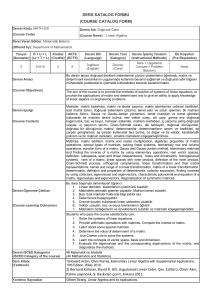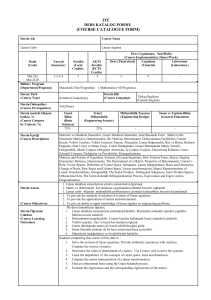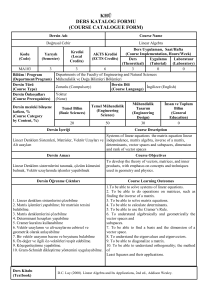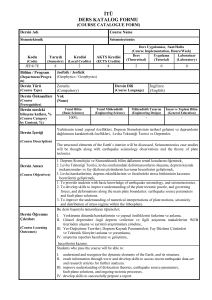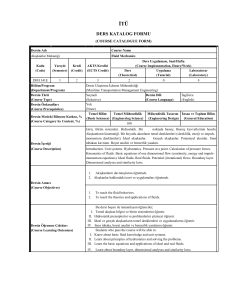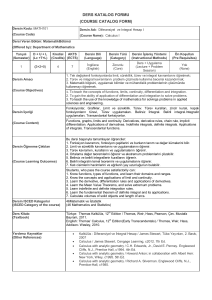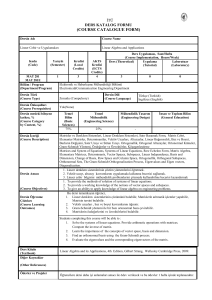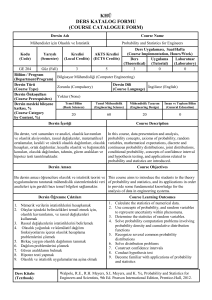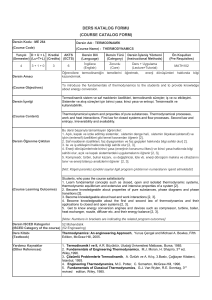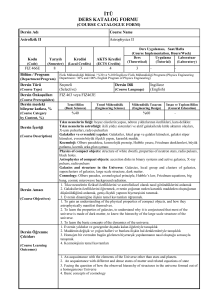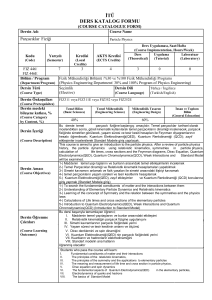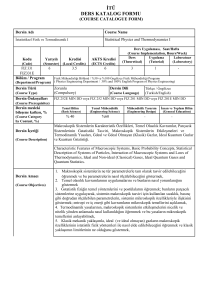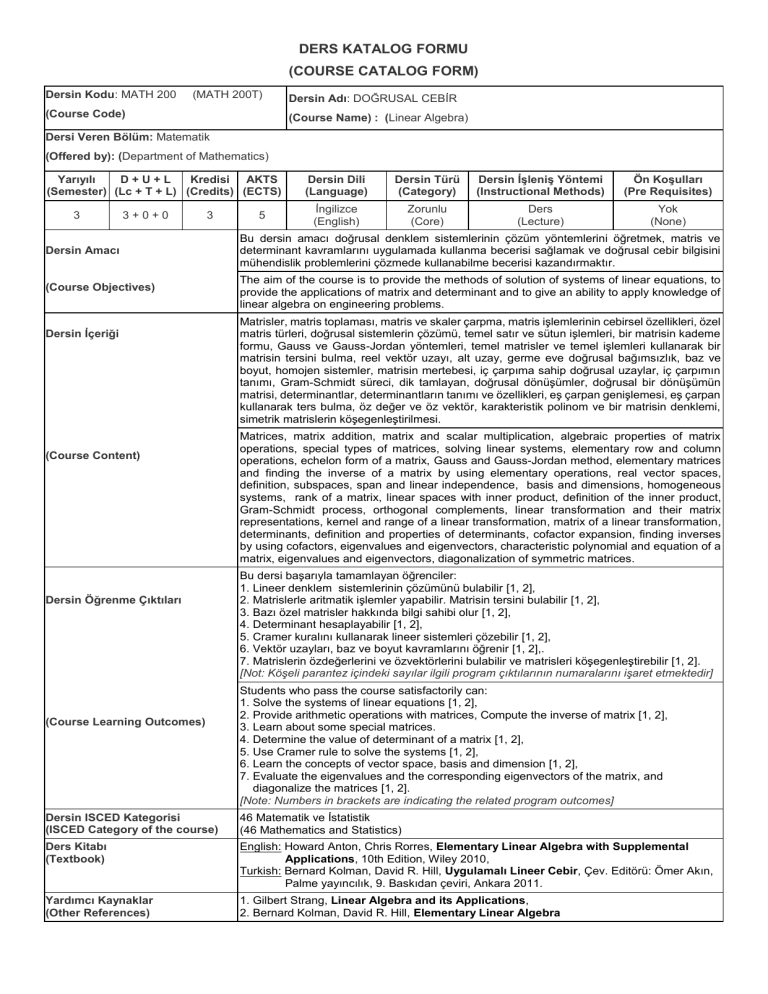
DERS KATALOG FORMU
(COURSE CATALOG FORM)
Dersin Kodu: MATH 200
(MATH 200T)
(Course Code)
Dersin Adı: DOĞRUSAL CEBİR
(Course Name) : (Linear Algebra)
Dersi Veren Bölüm: Matematik
(Offered by): (Department of Mathematics)
Yarıyılı
D+U+L
Kredisi AKTS
(Semester) (Lc + T + L) (Credits) (ECTS)
3
3+0+0
3
5
Dersin Dili
(Language)
Dersin Türü
(Category)
Dersin İşleniş Yöntemi
(Instructional Methods)
Ön Koşulları
(Pre Requisites)
İngilizce
(English)
Zorunlu
(Core)
Ders
(Lecture)
Yok
(None)
Dersin Amacı
Bu dersin amacı doğrusal denklem sistemlerinin çözüm yöntemlerini öğretmek, matris ve
determinant kavramlarını uygulamada kullanma becerisi sağlamak ve doğrusal cebir bilgisini
mühendislik problemlerini çözmede kullanabilme becerisi kazandırmaktır.
(Course Objectives)
The aim of the course is to provide the methods of solution of systems of linear equations, to
provide the applications of matrix and determinant and to give an ability to apply knowledge of
linear algebra on engineering problems.
Dersin İçeriği
(Course Content)
Dersin Öğrenme Çıktıları
(Course Learning Outcomes)
Matrisler, matris toplaması, matris ve skaler çarpma, matris işlemlerinin cebirsel özellikleri, özel
matris türleri, doğrusal sistemlerin çözümü, temel satır ve sütun işlemleri, bir matrisin kademe
formu, Gauss ve Gauss-Jordan yöntemleri, temel matrisler ve temel işlemleri kullanarak bir
matrisin tersini bulma, reel vektör uzayı, alt uzay, germe eve doğrusal bağımsızlık, baz ve
boyut, homojen sistemler, matrisin mertebesi, iç çarpıma sahip doğrusal uzaylar, iç çarpımın
tanımı, Gram-Schmidt süreci, dik tamlayan, doğrusal dönüşümler, doğrusal bir dönüşümün
matrisi, determinantlar, determinantların tanımı ve özellikleri, eş çarpan genişlemesi, eş çarpan
kullanarak ters bulma, öz değer ve öz vektör, karakteristik polinom ve bir matrisin denklemi,
simetrik matrislerin köşegenleştirilmesi.
Matrices, matrix addition, matrix and scalar multiplication, algebraic properties of matrix
operations, special types of matrices, solving linear systems, elementary row and column
operations, echelon form of a matrix, Gauss and Gauss-Jordan method, elementary matrices
and finding the inverse of a matrix by using elementary operations, real vector spaces,
definition, subspaces, span and linear independence, basis and dimensions, homogeneous
systems, rank of a matrix, linear spaces with inner product, definition of the inner product,
Gram-Schmidt process, orthogonal complements, linear transformation and their matrix
representations, kernel and range of a linear transformation, matrix of a linear transformation,
determinants, definition and properties of determinants, cofactor expansion, finding inverses
by using cofactors, eigenvalues and eigenvectors, characteristic polynomial and equation of a
matrix, eigenvalues and eigenvectors, diagonalization of symmetric matrices.
Bu dersi başarıyla tamamlayan öğrenciler:
1. Lineer denklem sistemlerinin çözümünü bulabilir [1, 2],
2. Matrislerle aritmatik işlemler yapabilir. Matrisin tersini bulabilir [1, 2],
3. Bazı özel matrisler hakkında bilgi sahibi olur [1, 2],
4. Determinant hesaplayabilir [1, 2],
5. Cramer kuralını kullanarak lineer sistemleri çözebilir [1, 2],
6. Vektör uzayları, baz ve boyut kavramlarını öğrenir [1, 2],.
7. Matrislerin özdeğerlerini ve özvektörlerini bulabilir ve matrisleri köşegenleştirebilir [1, 2].
[Not: Köşeli parantez içindeki sayılar ilgili program çıktılarının numaralarını işaret etmektedir]
Students who pass the course satisfactorily can:
1. Solve the systems of linear equations [1, 2],
2. Provide arithmetic operations with matrices, Compute the inverse of matrix [1, 2],
3. Learn about some special matrices.
4. Determine the value of determinant of a matrix [1, 2],
5. Use Cramer rule to solve the systems [1, 2],
6. Learn the concepts of vector space, basis and dimension [1, 2],
7. Evaluate the eigenvalues and the corresponding eigenvectors of the matrix, and
diagonalize the matrices [1, 2].
[Note: Numbers in brackets are indicating the related program outcomes]
Dersin ISCED Kategorisi
(ISCED Category of the course)
46 Matematik ve İstatistik
(46 Mathematics and Statistics)
Ders Kitabı
(Textbook)
English: Howard Anton, Chris Rorres, Elementary Linear Algebra with Supplemental
Applications, 10th Edition, Wiley 2010,
Turkish: Bernard Kolman, David R. Hill, Uygulamalı Lineer Cebir, Çev. Editörü: Ömer Akın,
Palme yayıncılık, 9. Baskıdan çeviri, Ankara 2011.
Yardımcı Kaynaklar
(Other References)
1. Gilbert Strang, Linear Algebra and its Applications,
2. Bernard Kolman, David R. Hill, Elementary Linear Algebra
HAFTALIK KONULAR
Teorik Ders Konuları
Hafta
Ders Öğrenme Çıktıları
1
Doğrusal denklem sistemlerine giriş, Gauss eleme yöntemi.
2
Matrisler ve matris işlemleri, tersler, matrislerin cebirsel özellikleri.
3
Tersler, matrislerin cebirsel özellikleri, temel matrisler ve tersi bulmak
için bir yöntem.
1, 2
4
Doğrusal matrisler ve tersi alınabilir matrisler hakkında daha fazlası,
köşegen, üçgen ve simetrik matrisler.
3
5
Eş çarpan genişlemesi aracılığıyla determinantlar.
4
6
Satır indirgeme yöntemiyle determinant hesaplama.
4
7
Determinantların özellikleri ve Kramer kuralı.
8
Reel vektör uzayı, alt uzaylar.
6
9
Doğrusal bağımsızlık, koordinatlar ve bazlar.
6
10
Baz değiştirme.
6
11
Baz değiştirme, satır uzayı, sütun uzayı, sıfır uzayı.
6
12
Mertebe, geçersizlik.
6
13
Öz değerler ve öz vektörler, köşegenleştirme.
7
14
Köşegenleştirme.
7
1
2
4, 5
COURSE PLAN
Week
Topics
Course Learning Outcomes
1
Introduction to Systems of Linear Equations; Gaussian Elimination
1
2
Matrices and Matrix Operations; Inverses, Algebraic Properties of
Matrices.
2
3
Inverses, Algebraic Properties of Matrices; Elementary
Matrices and a Method for Finding inverse
4
More on Linear Systems and Invertible Matrices; Diagonal, Triangular,
and Symmetric Matrices.
3
5
Determinants by Cofactor Expansion.
4
6
Evaluating Determinants by Row Reduction.
4
7
Properties of the Determinants, Cramer’s Rule.
8
Real Vector Spaces; Subspaces.
6
9
Linear Independence; Coordinates and Basis.
6
10
Dimension; Change of Basis.
6
11
Change of Basis. Row Space, Column Space, and Null Space.
6
12
Rank, Nullity.
6
13
Eigenvalues and Eigenvectors; Diagonalization.
7
14
Diagonalization.
7
1, 2
4, 5
DERSİN DEĞERLENDİRME SİSTEMİ
(COURSE ASSESSMENT)
Adet (Quantity)
Katkı Oranı (Contribution) (%)
Kısa Sınavlar (Quizzes)
-
-
Dönem Ödevi / Projesi (Term Project)
-
-
14
10
Etkinlikler (Activities)
Yarıyıl İçi
Çalışmaları
(Semester
Activities)
Devam (Attendance)
Seminer (Seminars)
-
-
Ödevler (Homework)
7
0
Sunum (Presentations)
-
-
Ara sınavlar (Midterm Exams)
2
50
Proje (Project)
-
-
YARIYIL SONU SINAVI (FINAL EXAM)
Toplam (Total)
1
40
100
DERSİN MAKİNE MÜHENDİSLİĞİ PROGRAMI KAZANIMLARINA (ÇIKTILARINA) KATKISI
Makina Mühendisliği Program Kazanımları (Çıktıları)
1
2
3
1
Matematik, fen bilimleri ve makine mühendisliği alanı ile ilgili temel bilimlerde yeterli bilgi birikimi
2
İstatistik, doğrusal cebir ve mühendislik bilimleri (mekanik, termodinamik, malzeme bilimi) konularını
kavrama
3
Makine mühendisliği problemlerine matematik, fen ve mühendislik bilgisini uygulama becerisi,
4
Mesleki ve etik sorumluluk gereklerini kavrama
5
Mühendislik çözümlerinin küresel ve toplumsal etkilerini ele almak için gereken sağlık, çevre, güvenlik,
ekonomi, hukuk benzeri konularda çok yönlü eğitim
6
Çağımızın sorunlarını tanıma; proje yönetimi ve iş hayatındaki uygulamalar hakkında bilgi; girişimcilik,
yenilikçilik ve sürdürebilir kalkınma hakkında farkındalık
7
Deney tasarlama, gerçekleştirme, verileri analiz etme ve yorumlama becerisi
8
Mekanik ve ısıl sistemleri , bileşenleri, süreçleri,gerçekçi kısıt ve koşullar altında belirli gereksinimleri
karşılayacak şekilde tasarlama becerisi
9
Karmaşık mühendislik problemlerini (açık uçlu problem/ tasarım) tanımlama, biçimlendirme/ modelleme
ve çözme becerisi
10 Disipliniçi/çok disiplinli takımlar içerisinde iş görebilme ve bireysel çalışma becerisi
11 Yazılı, sözlü ve görsel araçlarla etkin iletişim kurma becerisi, en az bir yabancı dil bilgisi
12
13
Mühendislik mesleği ve kişisel gelişim için yaşam boyu öğrenmenin gerekliliği bilinci ve bu amaçla
kendi ihtiyacını tanıma ve geliştirme becerisi
Modern teknik ve araçları geliştirme, seçme ve kullanma becerisi; bilişim teknolojilerini etkin bir şekilde
kullanma becerisi
Katkı Derecesi: 1-düşük, 2-orta, 3-yüksek
CONTRIBUTION of the COURSE on MECHANICAL ENGINEERING PROGRAM OUTCOMES
Mechanical Engineering Program Outcomes
1
2
3
1
Adequate knowledge in mathematics, science and mechanical engineering basic subjects
2
A comprehension of statistics, linear algebra and engineering sciences (mechanics, thermodynamics,
materials science)
3
An ability to apply knowledge of mathematics, science, and engineering to mechanical engineering
problems
4
A comprehension of professional and ethical responsibility
5
The broad education necessary to discuss the impact of engineering solutions in a global and societal
context. Knowledge about contemporary issues and the global and societal effects of engineering
practices on health, environment, and safety; awareness of the legal consequences of engineering
solutions
6
A recognition of contemporary issues; project management and information about business life
practices; awareness of entrepreneurship, innovation, and sustainable development
7
An ability to design and conduct experiments, as well as to analyze and interpret data
8
An ability to design thermal and mechanical systems, components, or processes to meet desired needs
under realistic constraints and conditions
9
Ability to identify, formulate, and solve complex engineering problems (open ended problems/ design!);
ability to select and apply proper analysis and modeling methods for this purpose
10 Ability to work efficiently in intra-disciplinary and multi-disciplinary teams; ability to work individually
11
An ability to communicate effectively with written, oral, and visual means; knowledge of a minimum of
one foreign language
12
A recognition of the need for and an ability to engage in life-long learning; recognition of personal needs
and ability to improve him/herself
13
An ability to use modern engineering techniques, skills, and computing tools necessary for engineering
practice; ability to employ information technologies effectively
Contribution degree: 1-low, 2-medium, 3-high
AKTS - İŞ YÜKÜ TABLOSU (ECTS - WORK LOAD TABLE)
DERS ETKİNLİKLERİ
(COURSE ACTIVITIES)
Sayı
(Quantity)
Süre (Saat)
(Time (h))
İş Yükü (saat)
(Work Load (h))
Ders Süresi
(Lectures)
14
3
48
Yarıyıl Sonu Sınavı (Hazırlık Süresi Dahil)
(Fınal Exam (Preparation included))
1
21
21
Kısa Sınavlar (Hazırlık Süresi Dahil)
(Quizzes (Preparation included))
-
-
-
Uygulama
(Tutorial)
-
-
-
Seminer
(Seminars)
-
-
-
Sınıf Dışı Çalışma Süresi
(Out class working time)
-
-
-
Ödevler
(Homework)
7
4
28
Sunum
(Presentations)
-
-
-
Arasınavlar (Hazırlık Süresi Dahil)
(Midterm Exams (Preparation included))
2
14
28
Toplam İş Yükü (saat)
(Total Work Load (h))
125
Dersin AKTS Kredisi (Toplam İş Yükü / 25)
(ECTS Credits of the course (Total Work Load / 25))
Revizyon / Tarih
(Revision / Date)
17/03/2015
Koordinatör / Hazırlayan
(Coordinator / Prepared by)
Yard. Doç. Deniz Karlı (M.Demirkol)
5
Onaylayan
(Approved by)
Prof.Dr. Uğur Dursun

